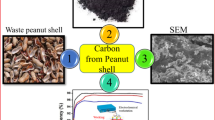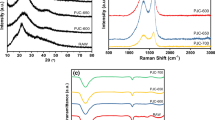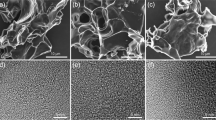Abstract
Activated carbons (ACs) derived from biomass have become one of the most promising electrode materials for supercapacitors due to their reproducibility and low cost. In this study, peanut shell is used as the precursor to prepare AC via one-step synthesis method activated by ZnCl2, FeCl3 and their mixture in N2 atmosphere at 700 °C. The characteristics and structure of the obtained ACs were studied by SEM, HR-TEM, BET, FT-IR, XRD and Raman spectroscopy. The prepared AC materials showed high specific surface area and large amount of micropores, and the maximum specific surface area reached 1481.59 m2/g. The etching effect of iron oxide and zinc chloride on the carbon skeleton facilitated the formation of micropores. The XRD pattern and Raman spectra indicated that all samples were amorphous carbons with some graphitic crystalline structures. In addition, FT-IR analysis illustrated that the surface of AC materials possessed a large number of oxygen-containing functional groups, which were beneficial to their electrochemical performance. From the electrochemical performance of the AC materials, it was observed that better electrochemical properties were achieved at a weight ratio of biomass to activator of 2:1 in comparison with 0.8:1 and 4:1 for all the activators. The obtained AC showed a high specific capacitance of 239.88 F/g at the current density of 0.5 A/g in 1 M Na2SO4 electrolyte and exhibited excellent cycling performance with 94.55% capacity retention after 5000 cycles.








Similar content being viewed by others
References
H.L. Cao, X.F. Zhou, Z.H. Qin, Low-temperature preparation of nitrogen-doped graphene for supercapacitors. Carbon 56, 218–223 (2013)
H. Jin, X.M. Wang, Z.R. Gu, A facile method for preparing nitrogen-doped graphene and its application in supercapacitors. J. Power Sources 273, 1156–1162 (2015)
Y. Gao, Y.S. Zhou, M. Qian, Chemical activation of carbon nano-onions for high-rate supercapacitor electrodes. Carbon 51, 52–58 (2013)
L. Zhao, L.Z. Fan, M.Q. Zhou, Nitrogen-containing hydrothermal carbons with superior performance in supercapacitors. Adv. Mater. 22, 5202–5206 (2010)
M. Inagaki, H. Konno, O. Tanaike, Carbon materials for electrochemical capacitors. J. Power Sources 195, 7880–7903 (2010)
J.R. Miller, P. Simon, Materials science-electrochemical capacitors for energy management. Science 321, 651–652 (2008)
J. Vatamanu, Z.Z. Hu, D. Bedrov, Increasing energy storage in electrochemical capacitors with ionic liquid electrolytes and nanostructured carbon electrodes. J. Phys. Chem. Lett. 4, 2829–2837 (2013)
H. Wang, H. Dai, ChemInform abstract: strongly coupled inorganic-nano-carbon hybrid materials for energy storage. Chem. Soc. Rev. 44, 3088–3113 (2013)
Z.Y. Lu, X.C. Wu, M. Jiang, J.F. Liu, X.D. Lei, X.M. Sun, Transition metal oxides/hydroxides nanoarrays for aqueous electrochemical energy storage systems. Sci. China-Mater. 57, 59–69 (2014)
C.J. Jafta, F. Nkosi, L.I. Roux, M.K. Mathe, M. Kebede, K. Makgoga, Y. Song, D. Tong, M. Oyama, N. Manyala, S.W. Chen, K.I. Ozoemena, Manganese oxide/graphene oxide composites for high-energy aqueous asymmetric electrochemical capacitors. Electrochim. Acta 110, 228–233 (2013)
H. Zhu, X. Wang, F. Yang, X. Yang, Promising carbons for supercapacitors derived from fungi. Adv. Mater. 23, 2745–2748 (2011)
A.G. Pandolfo, A.F. Hollenkamp, Carbon properties and their role in supercapacitors. J. Power Sources 157, 11–27 (2006)
E. Frackowiak, F. Béguin, Carbon materials for the electrochemical storage of energy in capacitors. Carbon 39, 937–950 (2001)
Z. Li, Z.W. Xu, X.H. Tan, H.L. Wang, C.M.B. Holt, T. Stephenson, B.C. Olsen, D. Mitlin, Mesoporous nitrogen-rich carbons derived from protein for ultra-high capacity battery anodes and supercapacitors. Energy Environ. Sci. 6, 871–878 (2013)
M. Sevilla, R. Mokaya, Energy storage applications of activated carbons: supercapacitors and hydrogen storage. Energy Environ. Sci. 7, 1250–1280 (2014)
S. Pohlmann, B. Lobato, T.A. Centeno, A. Balducci, The influence of pore size and surface area of activated carbons on the performance of ionic liquid based supercapacitors. Phys. Chem. Chem. Phys. 15, 17287–17294 (2013)
S. Dutta, A. Bhaumik, K.C.W. Wu, Hierarchically porous carbon derived from polymers and biomass: effect of interconnected pores on energy applications. Energy Environ. Sci. 7, 3574–3592 (2014)
Y.G. Wang, Y.Y. Xia, ChemInform abstract: recent progress in supercapacitors: from materials design to system construction. Adv. Mater. 25, 5336–5342 (2013)
K.L. Sun, S.S. Yu, Z.L. Hu, Z.H. Li, G.T. Lei, Q.Z. Xiao, Y.H. Ding, Oxygen-containing hierarchically porous carbon materials derived from wild jujube pit for high-performance supercapacitor. Electrochim. Acta 231, 417–428 (2017)
G.F. Ma, F.T. Hua, K.J. Sun, Z.G. Zhang, E.K. Feng, H. Peng, Z.Q. Lei, Porous carbon derived from sorghum stalk for symmetric supercapacitors. RSC Adv. 6, 103508–103516 (2016)
B.H. Lu, L.Y. Hu, H.Y. Yin, X.H. Mao, W. Xiao, D.H. Wang, Preparation and application of capacitive carbon from bamboo shells by one step molten carbonates carbonization. Int. J. Hydrog. Energy 41, 18713–18720 (2016)
C.Y. Zhang, X.H. Zhu, M. Cao, M.L. Li, N. Li, L.Q. Lai, J.L. Zhu, D.C. Wei, Hierarchical porous carbon materials derived from sheep manure for high-capacity supercapacitors. Chemsuschem 9, 932–937 (2016)
X.Y. Chen, K. Wu, B. Gao, Q.Y. Xiao, J.H. Kong, Q. Xiong, X. Peng, X.M. Zhang, J.J. Fu, Three-dimensional activated carbon recycled from rotten potatoes for high-performance supercapacitors. Waste Biomass Valoriz. 7, 551–557 (2015)
D. Zeng, Y.P. Dou, M. Li, M. Zhou, H.M. Li, K. Jiang, F. Yang, J.J. Peng, Wool fiber-derived nitrogen-doped porous carbon prepared from molten salt carbonization method for supercapacitor application. J. Mater. Sci. 53, 8372–8384 (2018)
N.N. Guo, M. Li, X.K. Sun, F. Wang, R. Yang, Tremella derived ultrahigh specific surface area activated carbon for high performance supercapacitor. Mater. Chem. Phys. 201, 399–407 (2017)
S.S. Arya, A.R. Salve, S. Chauhan, Peanuts as functional food: a review. J. Food Sci. Technol. Mysore 53, 31–41 (2016)
F. Duan, J.P. Zhang, C.S. Chyang, Y.J. Wang, J. Tso, Combustion of crushed and pelletized peanut shells in a pilot-scale fluidized-bed combustor with flue gas recirculation. Fuel Process. Technol. 128, 28–35 (2014)
W.J. Xu, Q.L. Zhao, R.F. Wang, Z.M. Jiang, Z.Z. Zhang, X.W. Gao, Z.F. Ye, Optimization of organic pollutants removal from soil eluent by activated carbon derived from peanut shells using response surface methodology. Vacuum 141, 307–315 (2017)
L.Q. Mai, A. Minhas-Khan, X.C. Tian, K.M. Hercule, Y.L. Zhao, X. Lin, X. Xu, Synergistic interaction between redox-active electrolyte and binder-free functionalized carbon for ultrahigh supercapacitor performance. Nat. Commun. 4, 2923 (2013)
J. Ding, H. Wang, Z. Li, K. Cui, D. Karpuzov, X. Tan, A. Kohandehghan, D. Mitlin, Peanut shell hybrid sodium ion capacitor with extreme energy–power rivals lithium ion capacitors. Energy Environ. Sci. 8, 941–955 (2015)
S.P. Zhang, Q. Dong, L. Zhang, Y.Q. Xiong, High quality syngas production from microwave pyrolysis of rice husk with char-supported metallic catalysts. Bioresour. Technol. 191, 17–23 (2015)
A.L. Cazetta, O. Pezoti, K.C. Bedin, T.L. Sliva, A. Paesano, T. Asefa, V.C. Almeida, Magnetic activated carbon derived from biomass waste by concurrent synthesis: efficient adsorbent for toxic dyes. ACS Sustain. Chem. Eng. 4, 1058–1068 (2016)
F M. Rodríguez-Reinoso, Molina-Sabio, Activated carbons from lignocellulosic materials by chemical and/or physical activation: an overview, Carbon 30, 1111–1118 (1992)
M.J. Martin, M.D. Balaguer, M. Rigola, Feasibility of activated carbon production from biological sludge by chemical activation with ZnCl2 and H2SO4. Environ. Technol. Lett. 17, 667–671 (1996)
A.L. Cazetta, O. Pezoti, K.C. Bedin, T.L. Silva, A.P. Junior, T. Asefa, V.C. Almeida, Magnetic activated carbon derived from biomass waste by concurrent synthesis: efficient adsorbent for toxic dyes. ACS Sustain. Chem. 4, 1058–1068 (2016)
X. Zhu, F. Qian, Y. Liu, D. Matera, G. Wu, S. Zhang, J. Chen, Controllable synthesis of magnetic carbon composites with high porosity and strong acid resistance from hydrochar for efficient removal of organic pollutants: an overlooked influence. Carbon 99, 338–347 (2016)
G. Wang, L. Zhang, J. Zhang, A review of electrode materials for electrochemical supercapacitors. Chem. Soc. Rev. 41, 797–828 (2012)
L.L. Zhang, X.S. Zhao, Carbon-based materials as supercapacitor electrodes. Chem. Soc. Rev. 38, 2520–2531 (2009)
G. Salitra, A. Soffer, L. Eliad, Y. Cohen, D. Aurbach, Carbon electrodes for double-layer capacitors I. Relations between ion and pore dimensions. J. Electrochem. Soc. 147, 2486–2493 (2000)
E. Raymundo-Piñero, K. Kierzek, J. Machnikowski, F. Béguin, Relationship between the nanoporous texture of activated carbons and their capacitance properties in different electrolytes. Carbon 44, 2498–2507 (2006)
F. Ran, X.X. Zhang, Y.S. Liu, K.W. Shen, X.Q. Niu, Y.T. Tan, L.B. Kong, L. Kang, C.A. Xu, S.W. Chen, Super long-life supercapacitor electrode materials based on hierarchical porous hollow carbon microcapsules. RSC Adv. 5, 87077–87083 (2015)
H. Jiang, J. Ma, C.Z. Li, Mesoporous carbon incorporated metal oxide nanomaterials as supercapacitor electrodes. Adv. Mater. 24, 4197–4202 (2012)
Y. Gao, L. Li, Y. Jin, Y. Wang, C. Yuan, Y. Wei, G. Chen, J. Ge, H. Lu, Porous carbon made from rice husk as electrode material for electrochemical double layer capacitor. Appl. Energy 153, 41–47 (2015)
X. Tian, H. Ma, Z. Li, S. Yan, L. Ma, F. Yu, G. Wang, X. Guo, Y. Ma, C. Wong, Flute type micropores activated carbon from cotton stalk for high performance supercapacitors. J. Power Sources 359, 88–96 (2017)
D.W. Wang, G.L. Fang, T. Xue, J.F. Ma, G.H. Geng, A melt route for the synthesis of activated carbon derived from carton box for high performance symmetric supercapacitor applications. J. Power Sources 307, 401–409 (2016)
S. Gao, X. Li, L. Li, X. Wei, A versatile biomass derived carbon material for oxygen reduction reaction, supercapacitors and oil/water separation. Nano Energy 33, 334–342 (2017)
G. Tao, L. Zhang, L. Chen, X. Cui, Z. Hua, M. Wang, J. Wang, Y. Chen, J. Shi, N-doped hierarchically macro/mesoporous carbon with excellent electrocatalytic activity and durability for oxygen reduction reaction. Carbon 86, 108–117 (2015)
K.S. Xia, X.L. Tian, S.X. Fei, K. You, Hierarchical porous graphene-based carbons prepared by carbon dioxide activation and their gas adsorption properties. Int. J. Hydrog. Energy 39, 11047–11054 (2014)
Z.H. Ni, Y.Y. Wang, T. Yu, Z.X. Shen, Raman spectroscopy and imaging of graphene. Nano Res. 1, 273–291 (2010)
K.S. Subrahmanyam, S.R.C. Vivekchand, A. Govindaraj, C.N.R. Rao, A study of graphenes prepared by different methods: characterization, properties and solubilization. J. Mater. Chem. 18, 1517 (2008)
H. Oda, A. Yamashita, S. Minoura, M. Okamoto, T. Morimoto, Modification of the oxygen-containing functional group on activated carbon fiber in electrodes of an electric double-layer capacitor. J. Power Sources 158, 1510–1516 (2006)
G.P. Wang, L. Zhang, J.J. Zhang, A review of electrode materials for electrochemical supercapacitors. Chem. Soc. Rev. 41, 797–828 (2012)
K. Kierzek, E. Frackowiak, G. Lota, G. Gryglewicz, J. Machnikowski, Electrochemical capacitors based on highly porous carbons prepared by KOH activation. Electrochim. Acta 49, 515–523 (2004)
B.B. Chang, B.C. Yang, Y.Z. Guo, Y.L. Wang, X.P. Dong, Preparation and enhanced supercapacitance performance of porous carbon spheres with a high degree of graphitization. RSC Adv. 5, 2088–2095 (2015)
Q. Wang, J. Yan, Y.B. Wang, T. Wei, M.L. Zhang, X.Y. Jing, Z.J. Fan, Three-dimensional flower-like and hierarchical porous carbon materials as high-rate performance electrodes for supercapacitors. Carbon 67, 119–127 (2014)
K.T. Cho, S.B. Lee, J.W. Lee, Facile synthesis of highly electrocapacitive nitrogen-doped graphitic porous carbons. J. Phys. Chem. C 118, 9357–9367 (2014)
H.F. Yang, Y.H. Tang, X.G. Huang, L.X. Wang, Q.T. Zhang, Activated porous carbon derived from walnut shells with promising material properties for supercapacitors. J. Mater. Sci.: Mater. Electron. 28, 18637–18645 (2017)
M.W. Xu, L.B. Kong, W.J. Zhou, H.L. L, Hydrothermal synthesis and pseudocapacitance properties of alpha-MnO2 hollow spheres and hollow urchins. J. Phys. Chem. C 111, 19141–19147 (2007)
Acknowledgements
This work was financially supported by the National Natural Science Foundation of China (No. 51876217).
Author information
Authors and Affiliations
Corresponding author
Electronic supplementary material
Below is the link to the electronic supplementary material.
Rights and permissions
About this article
Cite this article
Guo, F., Jiang, X., Li, X. et al. Carbon electrode material from peanut shell by one-step synthesis for high performance supercapacitor. J Mater Sci: Mater Electron 30, 914–925 (2019). https://doi.org/10.1007/s10854-018-0362-9
Received:
Accepted:
Published:
Issue Date:
DOI: https://doi.org/10.1007/s10854-018-0362-9




